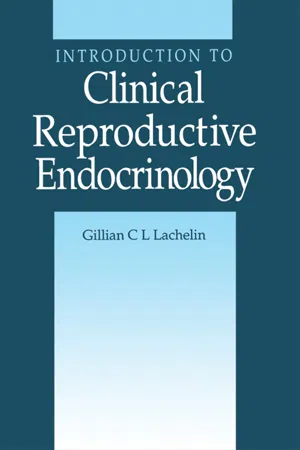Hormones
Hormones were defined classically, by Starling, as chemical transmitters released from specialized cells into the bloodstream and carried thence to other responsive cells where they exert their effects.
It has been realized that the situation is much more complicated than this, that many cells (including those of unicellular organisms) can produce a variety of hormones, and that the formation of endocrine glands is a relatively late development in evolution. This explains why more and more hormones are being shown to be produced physiologically in unexpected sites and also pathologically by malignant cells.
Hormones provide a means of communication, not only at a distance but also locally between and within cells. The term paracrine effect indicates the response of a group of cells to a hormone which diffuses locally from its site of production in a neighbouring group of cells (Figure 1.1). An autocrine effect is the response of a cell to its own hormones.
Figure 1.1 Paracrine (localized) hormone action
Mechanism of action of trophic hormones
Peptide and glycoprotein trophic hormones (including hypothalamic releasing hormones and some of the anterior pituitary hormones) act by binding to specific receptors in the cell membranes on the surface of target cells. They do not enter the cells but stimulate intracellular activity by a variety of mechanisms. Most of the polypeptide hormones stimulate the adenyl cyclase system causing the conversion of adenosine 5′-triphosphate to the second messenger cyclic adenosine 3′5′-monophosphate, which activates production of the relevant hormone. In the case of the hypothalamic releasing hormones other second messengers such as inositol 1,3,4-triphosphate and diacylglycerol are involved and there is an increase in intracellular calcium levels.
The hypothalamus
The structure of the hypothalamic–pituitary region is shown in diagrammatic form in Figure 1.2.
Figure 1.2 Diagrammatic representation of the hypothalamic-pituitary region
The hypothalamus is a small region of the brain, only weighing approximately 10 g. It lies at the base of the brain just above and posterior to the optic chiasma and is adjacent to the anterior part of the third ventricle. It consists of medial and lateral areas. The medial hypothalamic area is subdivided into a number of smaller regions, including the preoptic, paraventricular, supraoptic and anterior hypothalamic nuclei (in the anterior group), the ventromedial, dorsomedial, lateral tuberal and arcuate nuclei (in the tuberal group) and the posterior hypothalamic, mamillary, supramamillary and tuberomamillary nuclei (in the posterior group). Most of the neurones which produce hypothalamic hormones are thought to be in the tuberal area. The lateral hypothalamic area lies lateral to the medial hypothalamic area; it contains neurones which connect the rest of the brain with the medial hypothalamic nuclei.
Neurones are highly differentiated cells. They consist of a cell body (containing the nucleus), an axon and a number of dendrites (Figure 1.3). Axons vary in length from being very short to up to a metre or more long. They end at synapses in a number of axon terminals. Communication at a synapse is achieved by release of chemical transmitters stored in vesicles in the presynaptic axon. Some neurotransmitters, such as the catecholamines, acetylcholine, serotonin and γ-aminobutyric acid (GABA), are produced in the nerve terminals, whereas others are produced in the cell body. Thus the cell bodies of neurones originating in the supraoptic and paraventricular nuclei produce peptides that are transported down their axons and released from the axon terminals; they also communicate with other neurones via conventional synapses.
Several hypothalamic hormones are secreted directly from axon terminals in the median eminence into the highly innervated capillaries of the hypothalamus which drain into the portal vessels. The portal vessels supply the anterior lobe of the pituitary and thus deliver hypothalamic hormones to the anterior pituitary.
It is possible that blood also flows in the portal veins in a retrograde manner from the pituitary to the hypothalamus (Bergland and Page, 1978). Substances can also pass from the cerebrospinal fluid to the portal plexus (and possibly in the opposite direction; Bergland and Page, 1978) via tanycytes, as well as being secreted directly into the cerebrospinal fluid by secretory neurones. Tanycytes are specialized ciliated ependymal cells whose cell bodies line the third ventricle; they extend down to the median eminence.
The term blood–brain barrier refers to the fact that most brain capillaries are less permeable than capillaries in the rest of the body, as they do not have fenestrations in their endothelial cells and because they are covered by astrocytic processes. These differences from other capillaries are not, however, found in the capillaries of the median eminence, which therefore lies outside the blood–brain barrier.
It has been shown that a large number of peptides are produced in the central nervous system (CNS). Their production may be widespread, as in the case of thyrotropin releasing hormone (TRH) and the opioid peptides, or localized. Their presence in particular sites can be mapped by immunocytochemical techniques using specific antibodies. Several peptide hormones are initially produced in the form of a prohormone that is then broken down into smaller units, as in the case of adrenocorticotrophic hormone (ACTH), β-melanocyte stimulating hormone (β-MSH), β-endorphin and other peptides which are derived from proopiomelanocortin. Neuropeptides are produced not only in the CNS but also in many peripheral tissues, including the placenta.
Specific steroid receptors, which allow negative and positive feedback by steroid hormones, have been demonstrated in the pituitary and in several areas of the hypothalamus, as well as in other parts of the brain, using labelled steroids.



